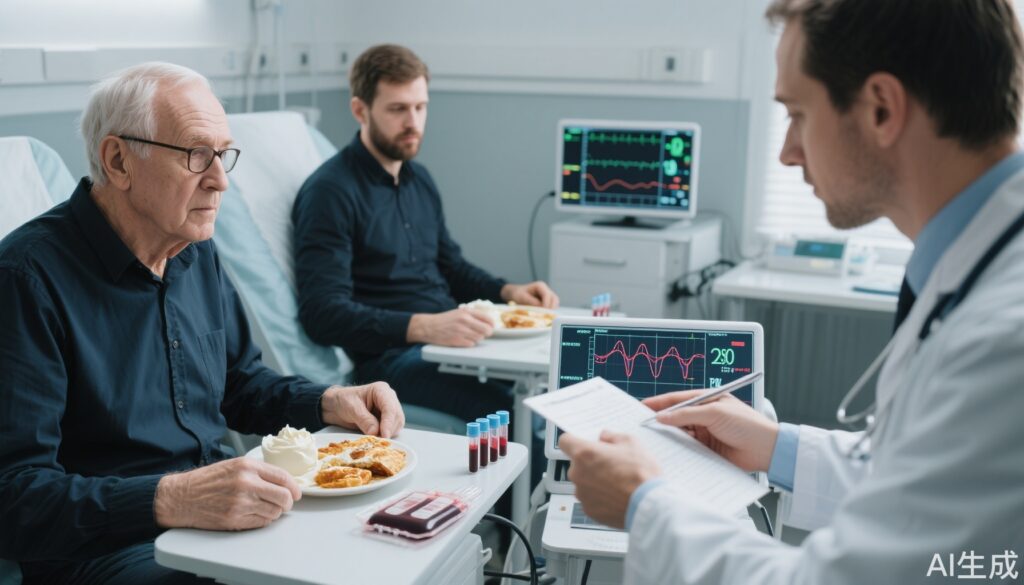Highlights
– A single standardized liquid high‑fat meal (130 g fat, 1,362 kcal) produced large rises in triglycerides, glucose and insulin and impaired systemic endothelial function (lower FMD) within 4 hours in healthy men.
– Dynamic cerebral autoregulation (dCA) declined after the meal in both young and older men, with older participants showing larger adverse changes and a positive correlation between postprandial triglycerides and increased cerebral pulsatility index.
– Mechanistic interpretation implicates postprandial oxidative/nitrosative stress and reduced nitric oxide bioavailability; clinical implications include potential cumulative cerebrovascular risk with frequent high‑fat meals, especially in older adults.
Study background and disease burden
Postprandial hyperlipidaemia (PPH) — a transient rise in circulating triglyceride‑rich lipoproteins after a fatty meal — is a physiological response that can last several hours. Repeated or exaggerated PPH is recognized as an atherogenic and pro‑oxidative state and has been associated with endothelial dysfunction, inflammation and increased arterial stiffness. Vascular endothelial dysfunction and impaired cerebral blood‑flow regulation are established contributors to cardiovascular and cerebrovascular risk, including myocardial infarction, stroke and possibly cognitive decline.
Clinically, the post‑meal period is not benign: most people spend long portions of the day in postprandial states, and modern dietary patterns with energy‑dense, high‑fat meals may amplify transient vascular insults. Understanding the immediacy and scale of these effects, and whether older adults are disproportionately affected, has implications for dietary counseling and secondary prevention strategies.
Study design
This controlled physiological study (University of New South Wales) enrolled 20 healthy young males (mean age ~24 years) and 21 healthy older males (mean age ~67 years). Inclusion criteria restricted enrolment to non‑smokers without known cardiovascular, pulmonary or cerebrovascular disease and excluded those taking nutritional supplements or antioxidant/anti‑inflammatory medications. Participants fasted overnight and then consumed a standardized liquid high‑fat meal containing 130 g of fat and 1,362 kcal (350 mL cream, two tablespoons chocolate syrup, one tablespoon skim milk powder). Measurements were repeated at baseline and 4 hours post‑meal.
Primary physiological assessments included:
– Blood biomarkers: triglycerides, glucose, insulin.
– Systemic endothelial function: brachial artery flow‑mediated dilation (FMD).
– Cerebral haemodynamics: transcranial Doppler‑derived measures including middle cerebral artery velocity, pulsatility index (PI), cerebrovascular resistance indices, and assessment of dynamic cerebral autoregulation (dCA) using established transfer‑function or time‑domain techniques.
This was a within‑subject pre‑post experimental design with age‑group comparisons; no placebo meal or crossover arm was reported in the summary provided.
Key findings
Biochemical response
– Both age groups exhibited marked postprandial rises in triglycerides, glucose and insulin at 4 hours.
– Mean triglyceride increases were substantial: young males rose from 0.88 mmol/L to 2.26 mmol/L; older males rose from 1.39 mmol/L to 2.92 mmol/L.
Systemic endothelial function
– Flow‑mediated dilation (FMD), a validated surrogate of endothelial nitric oxide–dependent vasodilator function, declined in both groups after the meal. The absolute declines were approximately 0.7 percentage points in the young group and 1.2 percentage points in the older group.
– Although numerically modest, such acute reductions in FMD are physiologically meaningful because they reflect impaired endothelium‑dependent vasodilation and are associated with increased cardiovascular risk when recurrent or sustained.
Cerebral haemodynamics and autoregulation
– Pulsatility index (PI) of cerebral arteries increased significantly in both groups after the meal. PI is a composite marker often interpreted as reflecting downstream vascular resistance and arterial stiffness; increases in PI suggest greater cerebrovascular impedance.
– In older males specifically, the percentage change in PI correlated positively with the postprandial triglyceride concentration: higher triglycerides were associated with larger increases in cerebral PI.
– Baseline (pre‑meal) differences were noted: older men had lower resting cerebral blood‑flow velocities, lower indices of vascular conductance including oxygen and glucose delivery, and higher cerebrovascular resistance and PI compared with younger men — consistent with age‑related cerebrovascular changes.
– Dynamic cerebral autoregulation (dCA) deteriorated after the high‑fat meal in both age groups. dCA quantifies the brain’s ability to stabilize blood flow during transient blood‑pressure changes; a reduction implies the brain becomes more pressure‑passive and dependent on systemic blood‑pressure swings. The impairment was more pronounced in older participants.
Mechanistic interpretation
– The investigators attribute the vascular effects to postprandial oxidative and nitrosative stress leading to reduced bioavailability of nitric oxide (NO), an essential mediator of endothelial function and neurovascular regulation. Reduced NO would explain both impaired systemic vasodilation (FMD) and a compromised cerebral autoregulatory response. Age‑related increases in baseline oxidative stress may render older adults more susceptible.
Clinical relevance and effect size considerations
– The acute biochemical and functional changes reported — large triglyceride excursions and measurable declines in FMD and dCA within 4 hours — are biologically plausible and clinically relevant when repeated frequently.
– The magnitude of FMD reduction (≈0.7–1.2%) is comparable to changes seen with other acute cardiovascular stressors (e.g., smoking, hyperglycaemia) and may be meaningful in longitudinal risk accumulation.
Safety findings
– The protocol involved a single acute exposure in otherwise healthy volunteers; no safety events were reported in the summary. The meal was an extreme fat load by design to elicit a robust PPH.
Expert commentary
Biological plausibility
– The sequence triglyceride‑> oxidative/nitrosative stress‑> lower NO bioavailability‑> endothelial dysfunction is consistent with prior mechanistic studies linking postprandial lipoproteins to endothelial injury. Increased arterial stiffness and pulsatility in the cerebral circulation logically follow impaired endothelial and smooth muscle responses.
Limitations and generalisability
– Sample and population: The study enrolled only males and excluded people with comorbidities, limiting generalisability to women and to patients with metabolic or vascular disease who may respond differently.
– Meal composition and realism: The test meal (130 g fat; 1,362 kcal, predominantly cream) represents an exaggerated, controlled challenge rather than a typical mixed meal. Real‑world meals vary in fat type, carbohydrate content, and timing, all of which modulate the postprandial metabolic response.
– Single timepoint post‑prandial assessment: Measurements at 4 hours capture a relevant time window but do not define the full temporal profile (e.g., peak responses or recovery). Serial measurements would better characterise duration and resolution.
– Mechanistic measures: While oxidative/nitrosative stress and reduced NO are proposed mechanisms, direct measurement of relevant biomarkers (e.g., plasma nitrite/nitrate, oxidized lipids, inflammatory cytokines) was not detailed in the summary; therefore mechanistic causality remains inferential.
Clinical implications and recommendations
– Recurrent exposure: Clinicians should recognise that frequent consumption of high‑fat, energy‑dense meals could produce repeated transient vascular insults that theoretically accelerate vascular ageing and end‑organ injury over time.
– Older adults: The amplified adverse cerebral effects in older men highlight the importance of targeted dietary counseling in older patients and those at elevated vascular risk.
– Mitigation strategies: Evidence from other studies suggests that meal composition (unsaturated vs. saturated fat), portion size, preceding or subsequent physical activity, and pharmacologic therapies (e.g., statins) can modulate postprandial lipaemia and endothelial responses. Antioxidant strategies have largely been inconsistent in clinical trials and cannot be recommended as replacements for dietary modification.
Guideline context
– Current dietary guidance from major cardiovascular organisations (e.g., AHA Presidential Advisory on Dietary Fats, 2017) recommends limiting saturated fat intake and favouring dietary patterns (Mediterranean, DASH) that reduce cardiovascular risk. The present findings reinforce the physiologic rationale for these recommendations by demonstrating acute functional consequences of an extreme high‑fat meal.
Conclusion
This controlled physiological study from the University of New South Wales provides compelling evidence that a single, large high‑fat meal can produce rapid and measurable impairments in systemic endothelial function and dynamic cerebral autoregulation within 4 hours in healthy men, with greater vulnerability observed in older participants. While the experimental meal was intentionally extreme to probe mechanisms, the findings are clinically meaningful: they underscore that postprandial physiology is an important window into vascular health and that repeated high‑fat meals may confer cumulative cerebrovascular risk. Clinicians should emphasise dietary patterns that limit excess saturated fat and caloric overload, particularly for older adults and those with existing vascular risk factors, and encourage lifestyle measures (weight management, regular physical activity) known to attenuate postprandial lipemic responses.
Future directions
– Replication in larger, mixed‑sex cohorts and in individuals with cardiometabolic disease is needed.
– Studies comparing realistic mixed meals and different fat types (saturated vs. unsaturated), and interventions such as pre‑meal exercise, omega‑3 supplementation, or pharmacologic agents (e.g., statins) could clarify mitigation strategies.
– Direct biomarker interrogation of oxidative/nitrosative stress and endothelial NO pathways would strengthen mechanistic links between PPH and acute cerebrovascular dysfunction.
References
– Post‑prandial hyperlipidaemia impairs systemic vascular function and dynamic cerebral autoregulation in young and old male adults.
– Sacks FM, Lichtenstein A, Wu JHY, et al. Dietary Fats and Cardiovascular Disease: A Presidential Advisory From the American Heart Association. Circulation. 2017;136:e1–e23.



